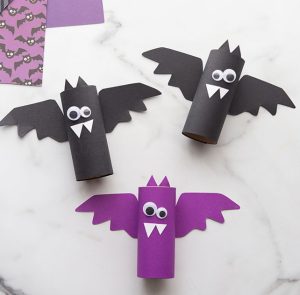Written by Samantha Walter-Cano for Kaitlyn McCarty
With the scary season around the corner, let’s talk about the animal with its infamous reputation for being one the spookiest around: the bat. When talking about bats, words like bloodsucker and vampires may come to mind. Despite their reputation, most bats are very tame and beneficial to humans. They are also the only mammal that can fly – making them unique. We will reject common myths about bats, discuss how these creatures live in nature, and how to participate in bat craft activities!
Where do bats live?
Contrary to what most think, not all bats live in caves. The Brazilian free-tailed bat, Florida’s primary bat species, is never found in caves. Instead, they reside in urban areas like stadiums and under bridges. They can also be found living in homes, attics, and chimneys. Bats live in caves, rock crevices, and trees in the wild. Keep an eye out for these remarkable creatures at night; you may see one flying around!
How do bats hunt?
Bats are super hunters, and their sharp senses allow them to catch their prey. These creatures are nocturnal, which means they sleep during the day and are active during the night. This is when they do most of their hunting. All 13 species of bats living in Florida are insectivores, meaning they eat a lot of insects such as moths, flies, and mosquitos! Bats have a sharp sense of smell and taste that help in finding food and can even locate other bats! In addition to smell and taste, bats rely on echolocation and sensors in their nightly hunt. Echolocation is when animals use echoes and sounds to find objects. When hunting, bats release high-pitched squeaks called ultrasounds. When the ultrasounds hit something, they bounce back like an echo, telling the bat where something is. Bats also have touch sensors on their wings. These sensors give them fast reflexes and the ability to avoid obstacles.
Bats are beneficial
Bats are very beneficial to humans and contribute to a balanced ecosystem. Bats can eat their body weight or more insects every night, making them an effective form of natural pest control. Bats also aid in natural pollination, and more than 300 fruit species depend on them for pollination. This includes bananas, avocados, and mangos.
Although bats are beneficial to humans and the environment, you should never try to handle one if you find it in the wild.
Bats in Florida
Believe it or not, Gainesville, Florida is home to the world’s largest occupied bat houses, and they are located on the University of Florida Campus. The houses are designed to occupy about 750,000 bats but are home to an estimated 450,000-500,000. Crowds can gather at night to watch these incredible creatures display their remarkable hunting skills!
Fun bat activities to do!
Bats are a ubiquitous symbol to be seen during the October season. There are many activities to engage kids in learning about bats while participating in this season’s fun. These fun activities below can be done in the classroom or at home!
Coffee filter bats
These are fun DIY bats that can be made in only 5 Steps!
From: Kristie Popa – UF/IFAS Extension Charlotte County 4-H Agent & Tycee Prevatt – UF/IFAS Glades County Extension CED/4-H Agent
Supplies needed:
- Wooden clothespin

Photo By: Kristie Popa. UF/IFAS Charlotte County Extension 4-H Agent - Round coffee filter
- Googly eyes
- Washable markers
- Spray bottle
- Water
- Black craft paint
- Paint brush, scissors
- Paint- white and black
- Construction paper
- Plastic grocery bag
Steps:
- Flatten your coffee filter and draw different patterns with several colors of washable markers. Darker colors are great for making bat wings! Place the coffee filter on the plastic bag and spray with water. Set aside to dry.
- Clip the clothespin on a piece of cardboard. Paint all sides of the clothespin with black craft paint. Set aside to dry.
- Once the paint on the clothespin dries, glue on the googly eyes. Use the white paint to draw a mouth and fangs.
- Fold the dry coffee filter in fourths and cut a scallop edge with the scissors. Unfold the coffee filter and cut a 3-inch slit up from the scalloped edge. Open the clothespin and insert the wings.
- Cut out ears using a rectangular strip of black card stock and cut out a small triangle on one end. Attach the paper to the top of the clothespin with glue.
Toilet paper roll bats
Not only are you recycling your toilet paper rolls, but you are creating a fun DIY bat that is the perfect decoration for the October season!
Craft by: Kimberly McLeod, The Best Ideas for Kids
Supplies needed:
-
- 3 Paper Rolls
- White and purple or black cardstock/paper
- Googly Eyes
- Scissors
- Glue or tape

Steps:
- Start by measuring and cutting out a piece of paper that will fit your toilet paper roll.
- Glue or tape the paper around your paper roll.
- Use cardstock to cut out the bat wings.
- Glue or tape the wings to the back of the paper roll.
- Cut out 2 small triangles for the bat ears and glue to the top front of the paper roll.
- Glue on 2 googly eyes on the front of the paper roll for the eyes.
- Cut out 2 white fangs from white paper and glue them on the front, under the googly eyes.
- OPTIONAL: tape string to the bottom of the paper roll and hang the bat upside down off any surface!
*Instead of gluing paper to the roll, you can also paint it!
References
“About the Houses.” Florida Museum, 12 Aug. 2022, https://www.floridamuseum.ufl.edu/bats/houses/.
“The Bats of the University of Florida Bat House.” Florida Wildlife Extension at UF/IFAS, https://wec.ifas.ufl.edu/extension/wildlife_info/wildlife_uf/bathouse.php.
“Where Do Bats Live?” Where Do Bats Live? | U.S. Geological Survey, https://www.usgs.gov/faqs/where-do-bats-live.
Hoose, Natalie Van. “The Ultimate Campus Move-in Challenge: Rehoming UF’s Iconic Bat Colony.” University of Florida News, 11 Aug. 2022, https://news.ufl.edu/2022/08/bat-house-renovation/.
Mcleod, Kim. “Toilet Paper Roll Bats.” The Best Ideas for Kids, 1 Feb. 2022, https://www.thebestideasforkids.com/toilet-paper-roll-bats/.
Popa, Kristie and Tycee Prevatt. “Coffee Filter Bat Activity” STEAM To Go! Crafty Clover Kit.
 0
0

